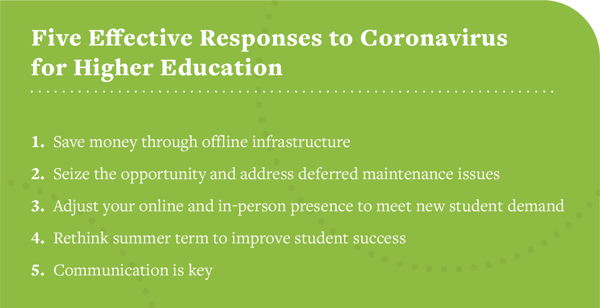The COVID-19 (coronavirus) pandemic has created an unprecedented response from higher education, with nearly every institution across the United States shifting students to online and distance learning. Closing physical campuses was a necessity to keep students, faculty, staff, and the broader community safe. While the pandemic has brought unanticipated challenges to institutions of higher education, there are still opportunities for transforming institutional infrastructure and internal resources:
1. Save Money through Offline Infrastructure.Closing buildings may initially seem like a relatively simple task, but there are important considerations to saving resources. Ad Astra works with many large colleges and universities in the southern United States where it becomes exceedingly hot in the summer. The summer months at a traditional public land-grant university or state college have meant that many of their largest classrooms and buildings are no longer needed. Over the past years, some of these institutions significantly scale back the cooling of their largest rooms (think a 300-seat lecture hall), and even some of their largest classroom buildings. Keeping the room or building temperate at 88 degrees rather than 72 degrees can save tens of thousands of dollars over the course of a summer, depending upon the size of the institution and the amount of space that goes offline. Additional savings will occur in maintenance avoidance due to decreased usage of air handlers and coolers during the following months.
If your institution has never taken courses or buildings offline, Bill Stimson, Systems Analyst at Arizona University offers a couple of pieces of advice. First, make sure you lock or close the space. Just because you do not centrally schedule space does not guarantee it will not be used. Second, allow for ample time for the space to come back online. Mr. Stimson says that at his institution, it takes 3-5 days for a large lecture hall to cool down from 88 degrees. Since air handlers cannot run constantly, it is important to leave ample time for all your facilities to come back online. While the COVID-19 pandemic has occurred during a relatively mild time of year, campuses should ensure they are not wasting resources on cooling or heating during this time.
2. Seize the Opportunity and Address Deferred Maintenance Issues.
During the beginning of the pandemic, Michigan State University announced that they are offering students $1,120 to move out early since the remainder of their in-person spring semester was canceled. Institutions should constantly evaluate when it is safe for employees and students to return to campus. However, the downtime may yield an opportunity for institutions with the available capital to commit to a thorough cleaning of the buildings, and then make capital improvements, that are often limited by the calendar (numerous projects may need to be completed on a building, but the summer down-time only affords three months, so projects must be prioritized). The longer lead-time of infrastructure downtime can lead to more projects accomplished and fresh buildings and facilities when faculty, staff, and students return.
3. Adjust Your Online and In-Person Presence to Meet New Student Demand.
The massive shift from in-person to online education during the pandemic has also affected students. Perhaps many students who were reticent or reluctant to take an online course may now have a preference to take more. This is particularly common if they were successful, enjoyed the experience, and felt that they learned as much as in-person. Predicting adequate course demand may be challenging for an institution, particularly in uncertain times like gthe pandemic. While the near complete shift to all online is unprecedented, massive movements to online courses were not unheard of. Your institution is not the first to experience a rapid shift from in-person to online.
One institution that Ad Astra has worked with had to shift from residential and commuter students to online only. At another institution, prior to the pandemic, approximately 40 percent of the student credit hours by students admitted to “in-person” students at the physical campus (in-person students that are on-campus or commuters) are taken online. At some institutions, that number may be higher, but it appears that the “in-person, but online” number keeps growing with each successive semester for hundreds of institutions. Right sizing your online presence can help improve student satisfaction (students get the courses they need when they need them), improve student credit hour production, time-to-completion, and graduation rates.
4. Rethink Summer Semester to Improve Student Success.
Summer semester is an excellent opportunity for students to get caught up on their academic degree completion or get ahead. Research has found that students who enrolled in college coursework during their first summer after their first fall and spring were 4.3 percent more likely to graduate from a two-year institution within five years. At four-year institutions, students who enrolled in course work after their first year were an astonishing 15.7 percent more likely to graduate in five years! The reason is straightforward: if it takes 15 credits each fall and spring to graduate on time, the extra summer session courses can help a student get caught up if they fall behind, or if they want to graduate faster. Since many institutions had switched to pass/fail grading and are much more flexible with their incomplete policy, summer 2020 had the potential to have unprecedented enrollment, if institutions had strategies to capitalize on the student demand. Many institutions, like Boston College, had announced that their summer 2020 term was online only, and it was possible many institutions would remain online only. Some may have started in-person and were forced to return to online only if there was a re-emergence of Coronavirus. Ad Astra has several solutions that are designed to deal with summer enrollment demand that might be larger or smaller than prior historical demand. The key thing to remember is that for both students with courses affected by the pandemic and those who have fallen off track, the summer presented an opportunity for them to take online courses they needed to get degree requirements they needed and accelerate their path to graduation.
5. Communicate Effectively.
As with many human endeavors, success or failure is often determined by the effectiveness of individual and collective communication. In each of the above, communication can substantially improve the likelihood of an effective response to the pandemic at your institution. For example, when deciding to take buildings offline, Bill Stimson of Arizona State University noted that not only communicating that a building had been taken offline, but why (e.g. maintenance) was essential. Effective communication helped allay fears of uncertainty and to save time. Initially, when buildings were taken offline, faculty reached out to Bill and noted that while they were told they could not meet in those rooms, the rooms were empty when they checked, and they would like to know why they were not allowed to meet in the room. When an answer was provided (maintenance), it nearly always sufficed. However, the process of fielding numerous requests was a challenge to Bill and his staff and one that was easily avoided with effective communication in subsequent years.
Similarly, when adjusting to in-person and online offerings, one might be tempted to simply put a great number of courses online with little thought to in-person offerings. However, simply continuing the same in-person course offerings from prior years and adding one or two faculty to teach a large online section may push many more students to online and lower class utilization for in-person offerings, as well as impact student satisfaction or grades. When discussing the decision to make a substantial transition from in-person to online, deans, department chairs, registrars, and enrollment managers should engage and communicate directly with faculty and students. For deans and department chairs, this might mean engaging beyond a single department. For example, the decision to massively move online offerings in an Introduction to Sociology course may also have an impact on Psychology and Political Science as students who could take any of the three might prefer the online modality and move demand in those departments also. Helping students and faculty be proactively aware of why certain decisions are made and valuing their insights in the process can help your institution craft and effective response to the pandemic.
Regardless of your experiences, Ad Astra is here to help. Don’t hesitate to reach out to us for assistance on these topics or to help connect you with other institutions who have dealt with these issues.
To learn more, visit the Academic Planning Resource Center or download our report on the topic here.

References
Ad Astra. 2018. Bending the Curve: How Colleges and Universities Can Rethink the Course Schedule to Graduate More Students, Faster. Retrieved January 30, 2020 (https://www.aais.com/hesi-media-download-bending-the-curve-04568).
Attewell, Scott Heil, and Liza Riesel. “What is Academic Momentum? And Does It Matter?”
Educational Evaluation and Policy Analysis. Vol 34: 27 – 44 (https://journals.sagepub.com/doi/abs/10.3102/0162373711421958).
Marowski, Steve. 2020. “Michigan State University Offering Students More than $1,000 to Move Out
Early.” Michigan Live. Retrieved April 1, 2020 (https://www.mlive.com/news/ann-arbor/2020/03/michigan-state-university-offering-students-more-than-1000-to-move-out-early.html).
We want to hear from you!
Share your expertise in the comment section below.



